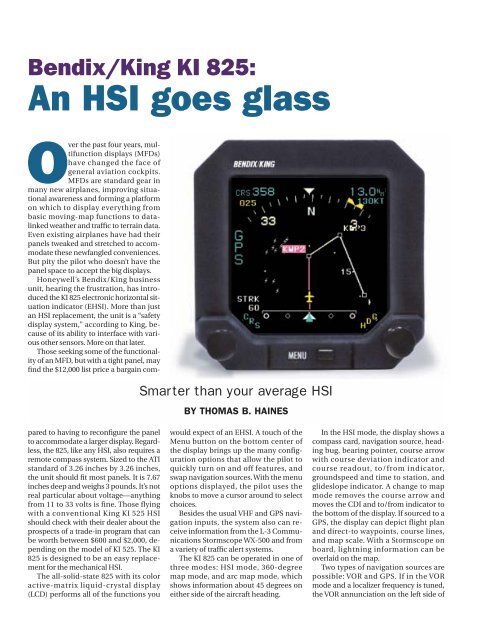Bendix/King KI 825
Bendix/King KI 825
Bendix/King KI 825
You also want an ePaper? Increase the reach of your titles
YUMPU automatically turns print PDFs into web optimized ePapers that Google loves.
<strong>Bendix</strong>/<strong>King</strong> <strong>KI</strong> <strong>825</strong>:An HSI goes glassSmarter than your average HSIBY THOMAS B. HAINESOver the past four years, multifunctiondisplays (MFDs)have changed the face ofgeneral aviation cockpits.MFDs are standard gear inmany new airplanes, improving situationalawareness and forming a platformon which to display everything frombasic moving-map functions to datalinkedweather and traffic to terrain data.Even existing airplanes have had theirpanels tweaked and stretched to accommodatethese newfangled conveniences.But pity the pilot who doesn’t have thepanel space to accept the big displays.Honeywell’s <strong>Bendix</strong>/<strong>King</strong> businessunit, hearing the frustration, has introducedthe <strong>KI</strong> <strong>825</strong> electronic horizontal situationindicator (EHSI). More than justan HSI replacement, the unit is a “safetydisplay system,” according to <strong>King</strong>, becauseof its ability to interface with variousother sensors. More on that later.Those seeking some of the functionalityof an MFD, but with a tight panel, mayfind the $12,000 list price a bargain comparedto having to reconfigure the panelto accommodate a larger display. Regardless,the <strong>825</strong>, like any HSI, also requires aremote compass system. Sized to the ATIstandard of 3.26 inches by 3.26 inches,the unit should fit most panels. It is 7.67inches deep and weighs 3 pounds. It’s notreal particular about voltage—anythingfrom 11 to 33 volts is fine. Those flyingwith a conventional <strong>King</strong> <strong>KI</strong> 525 HSIshould check with their dealer about theprospects of a trade-in program that canbe worth between $600 and $2,000, dependingon the model of <strong>KI</strong> 525. The <strong>KI</strong><strong>825</strong> is designed to be an easy replacementfor the mechanical HSI.The all-solid-state <strong>825</strong> with its coloractive-matrix liquid-crystal display(LCD) performs all of the functions youwould expect of an EHSI. A touch of theMenu button on the bottom center ofthe display brings up the many configurationoptions that allow the pilot toquickly turn on and off features, andswap navigation sources. With the menuoptions displayed, the pilot uses theknobs to move a cursor around to selectchoices.Besides the usual VHF and GPS navigationinputs, the system also can receiveinformation from the L-3 CommunicationsStormscope WX-500 and froma variety of traffic alert systems.The <strong>KI</strong> <strong>825</strong> can be operated in one ofthree modes: HSI mode, 360-degreemap mode, and arc map mode, whichshows information about 45 degrees oneither side of the aircraft heading.In the HSI mode, the display shows acompass card, navigation source, headingbug, bearing pointer, course arrowwith course deviation indicator andcourse readout, to/from indicator,groundspeed and time to station, andglideslope indicator. A change to mapmode removes the course arrow andmoves the CDI and to/from indicator tothe bottom of the display. If sourced to aGPS, the display can depict flight planand direct-to waypoints, course lines,and map scale. With a Stormscope onboard, lightning information can beoverlaid on the map.Two types of navigation sources arepossible: VOR and GPS. If in the VORmode and a localizer frequency is tuned,the VOR annunciation on the left side of
In the GPS Map mode(previous page), the<strong>KI</strong> <strong>825</strong> depicts flightplan waypoints androute along withlightning data. In thelocalizer mode (left),a glideslope indicatorappears on the rightside of the display.The GPS HSI mode(right) shows a fullcompass rose. Thewhite arrow in thebottom left of theimage points to thetuned VOR.The menu cursors arecontrolled by turningthe left and rightknobs (left). The <strong>KI</strong><strong>825</strong> brings a lot ofsituational awarenessto the cockpit of thisBeechcraft Baron(right).the display changes to a LOC annunciation.When a localizer with glideslope istuned, glideslope symbology appearsdown the right side of the display directingvertical guidance.A knob on the bottom right of the displaymoves the heading bug, which canbe auto-synchronized to the currentheading by tapping the Menu buttonand then holding the Menu button for asecond. In the VOR/LOC mode, theknob on the bottom left moves thecourse pointer. In GPS Leg mode, thecourse pointer is replaced with desiredtrack. When in the GPS omni-bearingselector mode, the course set knob selectsthe desired OBS course.Honeywell does a nice job of usingcolor to help orient the pilot to what isdisplayed and what mode the unit is in.For example, cyan is used to depict GPScourse information in the en routemode. When changed to the approachmode or when using VOR mode, the informationswitches to green. It’s a handyreminder during a GPS approach thatthe GPS receiver has truly switched tothe active approach mode.Using the menu options, the pilot canchoose what gets displayed. For example,in a GPS map mode, the flight-planroute might be displayed, with the activeleg in magenta and subsequent legsin white. The name of the active waypointwill be shown in white type overlaidon a magenta block. The pilot mightalso choose to overlay a second bearingpointer, tuned to a nearby VOR, for example.Or the second pointer could beused to point to a second waypoint if theaircraft has two GPS receivers. If the aircrafthas two VOR receivers, the pilotcan navigate to one and use the bearingpointer to show the other.When GPS information is available,the display shows the usual calculatedinformation you would expect, such asdistance to the waypoint and the pilotselectablechoice of either groundspeedor time to station below it.We had the opportunity to fly behindthe <strong>KI</strong> <strong>825</strong> on a sunny day and foundthe display to be highly readable bothstraight on and from an angle. In fact,the screen is easy to read even fromangles as great as 80 degrees.Honeywell has been making electronicdisplays for many years and seemsto have concentrated its efforts on makingthis one visiblei Links toadditionalinformationabout EHSIs maybe found onAOPA Online(www.aopa.org/pilot/links.shtml).Keyword search:EHSI.in all conditions.An avionics technicianwho has installedseveral <strong>KI</strong><strong>825</strong>s praised thesimplicity and eleganceof the design.From an installationstandpoint,the <strong>KI</strong> <strong>825</strong> is largelyself-contained, requiringno external relays and fewer wiresin general than most EHSIs. In addition,the unit is easily configured to accommodatea variety of avionics.E-mail the author at thomas.haines@aopa.orgReprinted from the September 2003 issue of AOPA Pilot © Copyright 2003 Aircraft Owners and Pilots Association
















